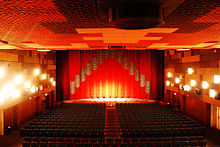Horticultural cinema
The Gartenbaukino is a cinema on Vienna's Ringstrasse in the Gartenbauhochhaus (between Palais Coburg and Stadtpark ). The cinema, which opened in 1919 and was rebuilt in 1960 at the same location, is one of the oldest and last still operating single-room cinemas in the city. The popular premiere cinema with a capacity of 736 visitors and a large screen has also been the main venue of the Viennale film festival since 1973 .
In 2006 the cinema counted around 91,000 visitors, half of which were due to normal operations or to special events.
history
The cinema opened on October 19, 1919 under the direction of Ludwig Domansky with Columbus discovered America . It owes its name to the kuk Gartenbau-Gesellschaft , in whose former exhibition hall the cinema with 639 seats was set up. The Austrian Horticultural Society is the owner of the cinema to this day. From 1919 to 1926 Domansky had the license to operate a cinema together with the association “Gesellschaft vom Silbernen Kreuz”, which had previously operated the “Kreuz Kino” in Wollzeile 17. From 1926 the gardening company had the cinema license. The cinema was now run by Marianne Domansky, Ludwig Domanky's widow. The capacity of the cinema was gradually increased from 477 in 1922 to around 500 seats in 1934.
The cinema became the location of numerous premieres with prominent guests. The premiere of Opernring in around 1936 led to a veritable crowd when the famous opera singer and leading actor Jan Kiepura sang his arias on the roof of a car in front of the cinema, as in the film.
After the Second World War, the KIBA cinema company took over the license and continued to run the cinema.
For a long time, the Gartenbaukino had the largest film screen in the city of Vienna. In the 1950s, along with the Apollo , Weltspiegel and Tabor , the cinema was one of the cinemas that showed films in widescreen format. It was the first cinema to be equipped with a cinemascope screen and the appropriate equipment.
Between 1959 and 1962 the entire horticultural site was redesigned. The horticultural building in which the cinema was located until then was also torn down and replaced by the horticultural high- rise . Robert Kotas , "house architect" of the Kiba cinema company , was entrusted with the design and construction of the new horticultural cinema . In 1960 the horticultural cinema was rebuilt with a capacity of 900 people. The premiere took place on December 19, 1960 with the film “Spartacus” (director: Stanley Kubrick), with the main actor Kirk Douglas and his wife Anne Buydens in attendance .
The cinema was designed from the beginning to be the most modern cinema in Vienna. It was the first cinema in Austria to have the option of showing 70 mm films and was subsequently also the first and only cinema with a Cinerama screen. It remained one of the classic Viennese “premiere cinemas” in the years to come. The film Schindler's List had its European premiere here in 1994 in the presence of director Steven Spielberg .
After the Forum cinema was closed in 1973, the Gartenbaukino became the main venue for the Viennale film festival .
In 2002, the cinema operator KIBA had to file for bankruptcy. The Viennale then took over the cinema with the support of the City of Vienna and has been operating it since then with the specially founded company “Entuziasm Kinobetriebs GesmbH” with Norman Shetler as managing director. Arguments for the preservation of the cinema were seen in the fact that the cinema was the last major premiere cinema in a central location, as well as in the modern and spacious architecture of the building, " which symbolizes an essential moment of urban culture ". From now on, the cinema should also be used as an event location for gala performances, special film series, concerts and commercial rentals, not least to support the financing and continued existence of the cinema.
Monument protection
In 2018 the Gartenbaukino was placed under monument protection. The decision of the Austrian Federal Monuments Office states: “ As the only preserved open-plan and single-room premiere cinema in Vienna from around 1960 and the venue for the Viennale, as well as one of the few well-preserved recreational architecture of post-war modernism in Vienna and Austria, the object comes as Document of the leisure culture of this time special importance ”.
Individual evidence
- ↑ a b Gartenbaukino press conference, December 2006 ( Memento from September 28, 2007 in the Internet Archive ) (PDF; 615 kB)
- ↑ Gartenbaukino: On the history of the cinema: The story before the story (accessed on January 19, 2019)
- ↑ https://www.vienna.at/gartenbaukino-das-wiener-wahrzeichen-der-cineasten-haben-unter-denkmalschutz/606466
- ↑ Monument protection for Gartenbaukino , ORF Vienna from January 18, 2019, accessed on January 25, 2019
Web links
- Horticultural cinema
- Gartenbaukino as an interactive 360 ° × 180 ° panorama photo (requires Adobe Flash )
Coordinates: 48 ° 12 ′ 20 " N , 16 ° 22 ′ 42" E



